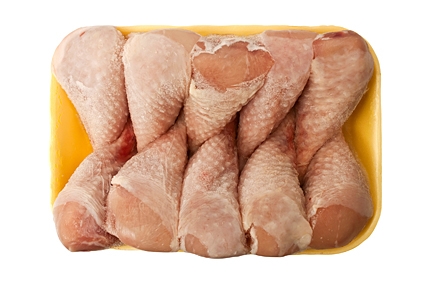Perdue Foods, Salisbury, Md., removed all antibiotics from its chicken hatcheries, setting a standard that defines the responsible use of antibiotics in poultry production and exceeding the Federal Drug Administration’s (FDA) voluntary guidelines for antibiotic use in food animals, as well as the standards of the USDA Organic certification program. Perdue does not use antibiotics for growth promotion in its chicken production, and has not since 2007. It does however use an animal-only antibiotic to control an intestinal parasite, and will use antibiotics to treat and control illness in sick flocks.
“By no longer using any antibiotics in our hatcheries or any human antibiotics in feed, we’ve reached the point where 95% of our chickens never receive any human antibiotics, and the remainder receives them only for a few days when prescribed by a veterinarian,” says Dr. Bruce Stewart-Brown, senior vice president of food safety, quality and live operations.
Eliminating antibiotic use in the hatchery has taken five years to fully implement, and is the latest stage of a 12-year evolution in the company’s approach to antibiotic use.
“This very limited use of antibiotics is more restrictive than the new FDA guidelines announced last December. We have yet to read any proposed legislation that we are not compliant with, and in fact, have been since 2008,” says Stewart-Brown.
“We listened to our consumers, and we are proud to have developed a responsible program that does not risk the medical effectiveness of antibiotics in human health, provides appropriate healthcare for animals and does not employ growth-promoting drugs,” says Jim Perdue, chairman. “While treating illness is a responsible part of animal care, we believe human-approved antibiotics should not be used to boost production or in place of responsible animal husbandry or hatchery management.”
“This is not something that you simply turn a switch to implement,” adds Stewart-Brown. “Moving away from the conventional use of antibiotics in animal agriculture means more than taking human antibiotics out of your programs. You have to develop programs from breeder operations through the hatchery and feed mill and onto the farm that are sustainable without that use. It takes a lot more effort with more stringent standards, but we believe this is what consumers expect from Perdue.”
The 12-year journey away from antibiotics
Perdue started the move away from conventional antibiotic use in 2002, in response to growing consumer concern and questions about the practice.
“We recognized that the public was concerned about the potential impact of the use of these drugs on their ability to effectively treat humans,” says Stewart-Brown. “We focused first on removing growth-promoting antibiotics.”
In 2005, the company phased out the use of specific medically important antibiotics in its feeds, including floroquinolones, four years before the FDA banned the use of floroquinolones in animal agriculture. By 2007, Perdue successfully removed all human antibiotics from its feed.
That same year, it launched the Harvestland brand, its first no-antibiotics-ever product line.
“That was a major learning experience for us,” says Stewart-Brown. “No-antibiotics-ever was a very small part of the market, but it gave the opportunity to learn what it takes to successfully run such a program. And, we took those learnings and applied them across our entire company.
“We also found that it is not realistic or responsible to eliminate all antibiotics. No matter how carefully you raise animals, some are going to be exposed to infections that can only be treated with antibiotics. As veterinarians, we have a responsibility to properly treat those animals,” says Stewart-Brown. “But, when we do treat chickens with antibiotics, we do it in a very focused and limited way that allows us to treat a single house and for the shortest duration possible, generally no longer than three days.”
Perdue is said to be the first to phase out the use of arsenic in chicken feed well before its market withdrawal.
“Again, we saw that consumers were becoming concerned about the practice,” says Stewart-Brown. “But, we found that through improved flock health programs and housing environments, we are able to produce healthy chickens without it.”
The final step was eliminating its use in the hatchery, a process that began in 2009 and culminated in the summer of 2014.
“Most hatcheries typically use small amounts of antibiotics when vaccinating the eggs,” says Stewart-Brown. “The primary purpose is to prevent infection from entering through the vaccination site. In fact, this use is even allowed by the National Organic Program, though we don’t allow it in our organic products. We invested in our hatcheries to create a clean environment, and are able to successfully vaccinate eggs without antibiotics.”
Supporting consumer choices and confidence
Through its roster of brands and products, Perdue offers consumers choices, including no-antibiotics-ever and organic.
“Our organic and no-antibiotics-ever products appeal to consumers looking for specific attributes,” says Eric Christianson, senior vice president of marketing. “But, all of our consumers can trust that our responsible animal health program ensures a minimal, safe and responsible use of antibiotics.”
Chickens raised for Perdue outside the organic and no-antibiotics-ever programs are generally treated to prevent common illnesses using an animal-only antibiotic not used in human medicine. Regardless of the program, should animals become ill, including organic and no-antibiotics-ever, they will be treated as medically appropriate as part of Perdue’s animal welfare commitment. However, if antibiotics are used, they are not marketed as no-antibiotics-ever or organic.
“There is a misperception at times that organic and no-antibiotics-ever programs entail withholding antibiotic treatment,” says Stewart-Brown. “Both the National Organic Program and responsibly written no-antibiotics-ever programs require the use of antibiotics when medically necessary. However, that philosophy does not justify the widespread use of human antibiotics in animal agriculture. We believe our less-than-5%-use rate demonstrates a responsible use of human antibiotics and responsible animal husbandry programs in which consumers can have confidence.”






